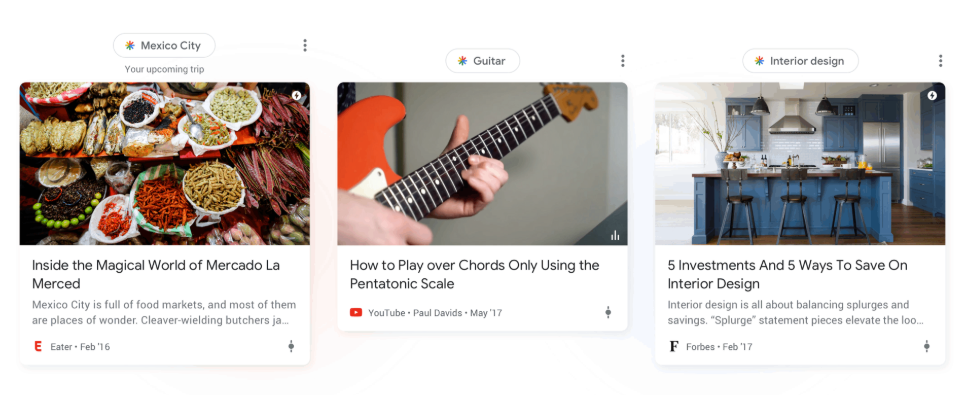Google has plenty of tools for content marketers, publishers, and SEO professionals to utilize. Apart from the obvious and more recognizable tools, such as Google Analytics, Google Search Console, and Google Search, there are a few others, including Google Discover.
Google Discover is a useful tool that can help drive a substantial amount of traffic to your content that you may later convert into leads and subscribers.
In this blog post, we take a look at Google Discover: what it is, its potential value for content marketers and publishers, and how to optimize your content for Google Discover.
What is Google Discover?
Google Discover was introduced on September 24, 2018, as an updated version of Google Feed — which was replaced by Google Discover a year after its introduction. Google Feed was used by more than 800 million people each update to stay updated with news and interesting information. This shows the immense potential of Google Discover.
Google defines Google Discover as:
“Discover is unique because it’s one step ahead: it helps you come across the things you haven’t even started looking for.”
And that’s a very apt description of what Google Discover does.
As you can see in the above image, Discover shows you content — based on your interests and preferences — that it believes you will find interesting.
If you like a topic, you can explore more content in that category with just a tap.
This process of uncovering fresh and interesting content, personalized to your needs, is intuitive and user-friendly, which encourages people to consume more content.
How to optimize content for Google Discover
Now that you know what Google Discover is let’s learn about the various tactics that content marketers and publishers can use to optimize for it.
1. Mobile-friendly content and website

One of the most important points to remember is that Google Discover works on mobile devices. It is only available on tablets and smartphones. Therefore, theoretically, all the traffic you get from Google Discover will come from mobile devices.
What if your website is not even mobile friendly?
As you can imagine, Google would not even rank contents from a website that is not mobile-friendly.
Google has been emphasizing on mobile traffic for many years now. Mobile traffic has become a crucial aspect of internet marketing and traffic; it has even surpassed desktop traffic. Considering that almost 100 percent of Google Discover traffic will come from mobile devices, it makes sense to not rank websites that aren’t mobile-friendly or easily accessible and navigable for mobile users.
Here are a few tips to help you optimize your website and content for mobile devices:
- Make sure your website is free of intrusive ads and pop-ups.
- Make sure your website is free of clutter. Because of a smaller real-estate on mobile screens, a minimalistic design approach is often preferred.
- The content on your site should be easily readable — even on smaller screens.
- Navigation can be a challenge on mobile devices. Pay special attention to it when designing your website for mobile.
- Structure your content in a way that visitors do not have to scroll down several times to get the most important information.
- Mobile users are generally on the go and want to consume information as quickly as possible. Therefore, it is important that your site loads within a couple of seconds. Check how long your website takes to load and follow these tips to improve the loading speed of your website.
2. Content types
Google Discover regularly features a variety of content. If you want to rank your content in Discover, it is a good idea to know the type of content that could be featured.
Case studies, white-papers, and PDFs are unlikely to be featured in the Discover feed. On the other hand, how-to articles, news content, and videos are more likely to be featured. Therefore, plan your content strategy accordingly.
3. Videos
Depending on the preferences of your target audience and your niche, you might require to create more videos.
As you can see in the above example, Google Discover ranks text-based content as well as videos in the feed.
A video for a guitar tutorial would obviously be more appropriate than a blog post. Knowing your content, your audience, and the most appropriate medium to convey information is the key.
4. Image optimization tips and techniques
One of the biggest and most important factors in ranking in Google Discover and getting a high CTR is the use of high-quality images in the content.
Google recommends using larger images instead of smaller thumbnails.
According to Google, content creators and publishers who use large images in place of thumbnails experience a 5 percent increase in CTR, a 3 percent increase in the average time spent on-page, and a 3 percent increase in overall user satisfaction.
Google recommends using images that are at least 1,200px wide.
Large images may have to be enabled in the Discover results. You can ensure that Google has the rights to display your images to users either by using AMP or by filling out this form for the opt-in program.
5. Content relevance and Discover algorithm
Understanding who your audience is and what type of content they want and would find useful can be very beneficial if your goal is to rank in Discover.
Content relevance is, after all, an integral aspect of Google Discover. Here is how Google describes how Discover’s algorithm works and ranks content:
“Discover content is algorithmically ranked by what Google thinks a user would find most interesting. Content ranking is powered by the strength of the match between an article's content and a user's interests, so there aren't any methods for boosting the ranking of your pages other than posting content that you think users will find interesting.”
And how do you post content that users will find interesting?
You start by understanding who your target audience is and what they would like. To improve that understanding, start with a buyer persona. You can also dive into your Google Analytics audience and behavior reports to learn more about your audience and how they engage with your content.
Conclusion
While Google Discover may not be your primary source of traffic, it may complement your traffic-generation efforts very well. Almost all traffic-generation methods require an origin — which is usually a keyword or keyword phrase that the user searches for.
However, Discover is different. It requires no origin. Instead of relying on the user to initiate the search query, it presents interesting and relevant content on its own that aligns with the user’s interests and preferences.
Apart from bringing additional traffic to your site, Google Discover can also help you “discover” more about your audience and website content. It can help you identify the type of content and images that resonate the best with your audience and the click-through rate (CTR) that you can expect with certain types of content.
You can use that information to reverse-engineer and create more content for your website that satisfies your audiences’ needs in a more effective way.
We recommend trying Google Discover and use different techniques to see what works best. If you have any questions, feel free to let us know by leaving a comment below.
